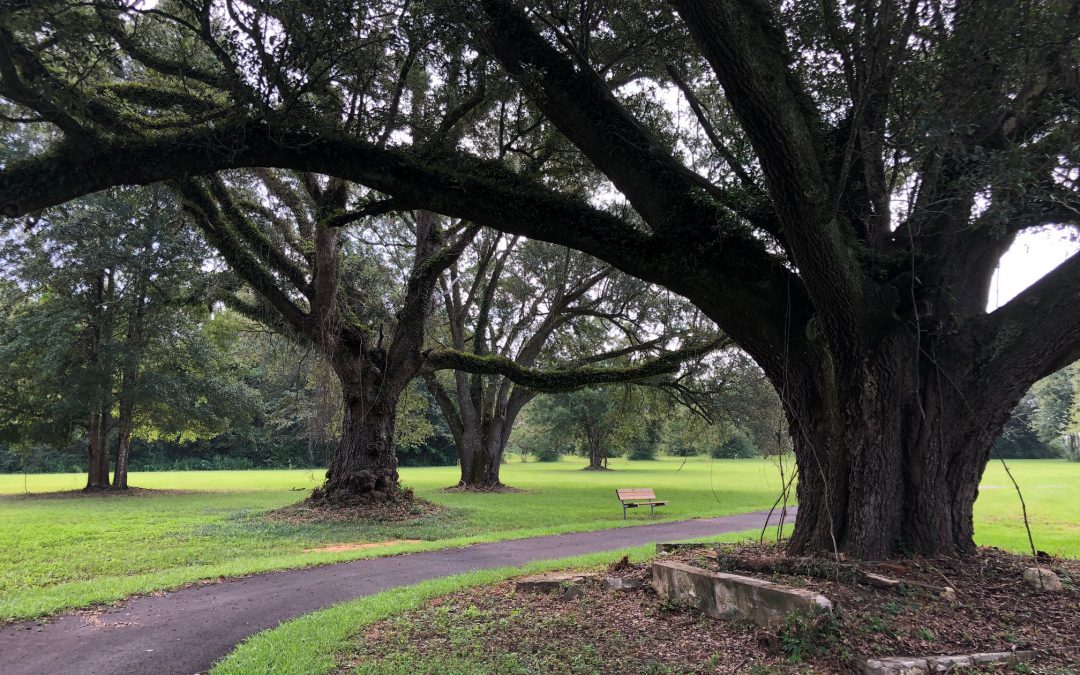
by Carrie Stevenson | Apr 16, 2019
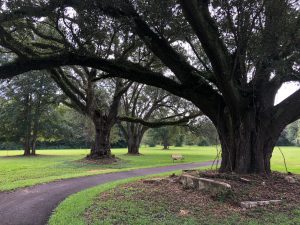
Historic live oaks provide shade and wildlife habitat at the Escambia Extension walking trail. Photo credit: Carrie Stevenson, UF / IFAS Extension
A recent study of 3-5 year olds found that the average pre-reading American child could identify hundreds of marketing brand logos (McDonald’s, Disney, even Toyota). Most researchers would be mightily challenged to find even a middle school student who can identify more than a couple of trees growing in their own backyard. The fields and forests many of us grew up in are steadily converting to look-alike suburban areas, so this lack of local natural knowledge is commonplace. As the quote by Senegalese forester Baba Dioum goes, “In the end, we will conserve only what we love; we will love only what we understand and we will understand only what we are taught.” If kids and adults do not appreciate and understand the natural world around them, we are unlikely to preserve these priceless wonders.
To do our part towards this aim of educating others, we at Escambia Extension received a grant from International Paper to plant 30 trees around our office’s walking track. Every tree has a clearly marked identification tag listing its common and botanical name.
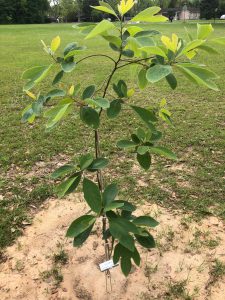
A newly planted sassafras tree on the Extension walking trail. Photo credit: Carrie Stevenson, UF / IFAS Extension
Initially we just planned to add more shade trees to the sunny side of the track, but after a discussion with local foresters, we realized this effort could be an ideal teaching tool. The local middle and high school Future Farmers of America (FFA) chapters participate in a tree identification contest, and are tasked with knowing 50 native tree species. While 10 of them were tropical species that do not perform well in north Florida, we have the other 40 planted here on the property. Students and any interested citizen interested in learning these native species can walk along our track, getting exercise and taking in the natural world around them.
A spring walking event will kick off the official opening of the tree identification trail, so join us April 26 to learn more about healthy living and the value of trees. Or, join us for an Extension Open House on April 27 to explore the demonstration gardens, purchase vegetable plants, or learn more about Extension’s wide array of community services.
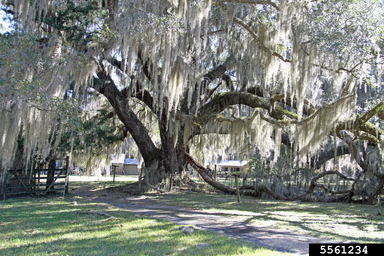
by Mark Tancig | Dec 17, 2018

Native trees, like this Live Oak (Quercus virginiana), provide habitat for various insects fed upon by birds. Source: James Holland, Bugwood.org
Planting native plants is a topic many north Florida gardeners, and subscribers to Gardening in the Panhandle, have seen covered in various ways and formats. It doesn’t take a great leap of understanding to realize that native plants are highly valued by our wildlife, which have adapted to living with these plants for millennia. However, we also get a lot of information about the latest, greatest landscape plant variety, many of which are non-native, and are lured to purchase them by their beautiful flowers and/or foliage. In the wake of Hurricane Michael, the importance of selecting native plants for the landscape becomes apparent when you look around and see whole forests severely disturbed. Furthermore, recent research has shown how much our native wildlife prefer native plants and need them for the best chances of survival.
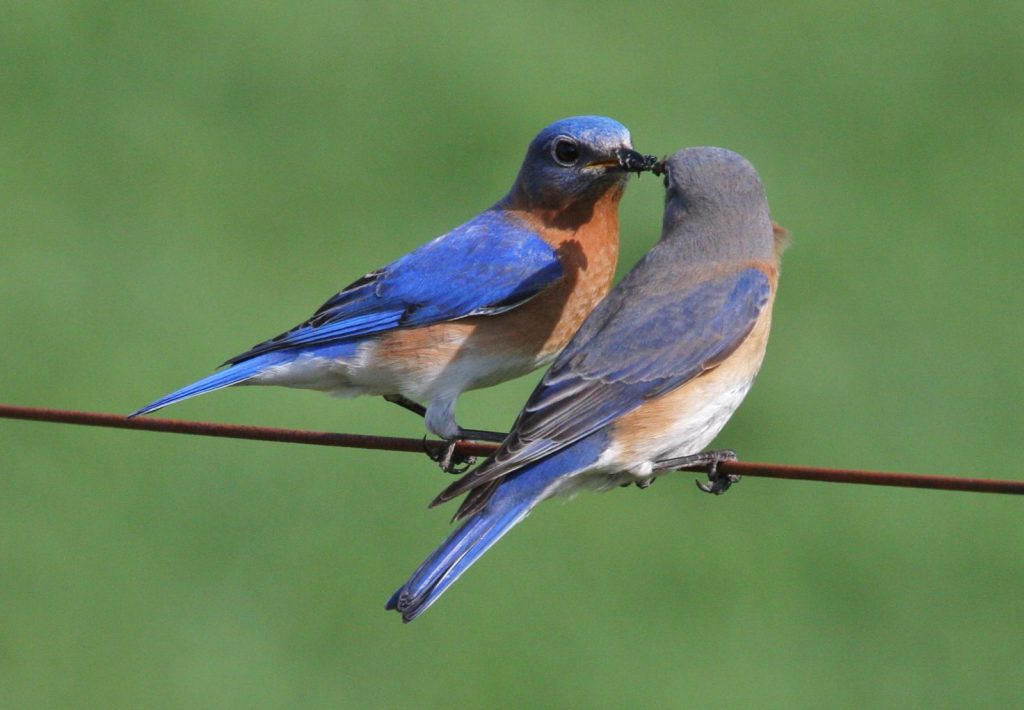
Eastern bluebirds are an example of a bird that relies on insects. Source: Sandysphotos, Creative Commons.
Why Native Plants?
It’s not that non-native ornamental plants are “bad”, unless they’re the terrible invasive, exotic species like kudzu, Chine privet, etc., it’s just that the food chains that support our wildlife are adapted to native plants. A recent report published in the National Proceedings of Science found that chickadees had far better success fledging young when they foraged landscape areas containing 70% or more native plant cover. The reason for their success was that the insects they feed on utilize native species more than non-native plant species. Does that mean non-natives provide no value? Not necessarily. Non-native ornamental plants can be important sources of nectar and pollen and, as you know from experience dealing with pest problems on non-native plants, they also support insects. Native plants just support more of an abundance of these insects.
Following a large disturbance like Hurricane Michael, many insects, birds, and other wildlife will likely see a decrease in numbers and/or reproductive success due to the loss and/or disruption of native plant ecosystems. As stated in the recent report, restoration of urban areas should prioritize native plants to support local food webs.
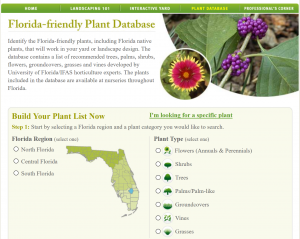
The FloridaYards.org website is a great resource to find native trees for your area. Source: Screenshot, FloridaYards.org.
The FloridaYards.org website is an easy way to start putting together a list of potential plants. The website’s Florida-Friendly Plant Database allows users to select the area of Florida they live in, site conditions, plant type (tree, shrub, etc.), and to specify native plants only. It then searches the database for plants that meet those conditions and creates a list of species, along with photos and care information. If you’re thinking about how these trees hold up to storms, you can cross-check that list with UF/IFAS’s Wind and Trees EDIS publication. Of course, if you have any questions along the way, please contact your local UF/IFAS Extension Office.
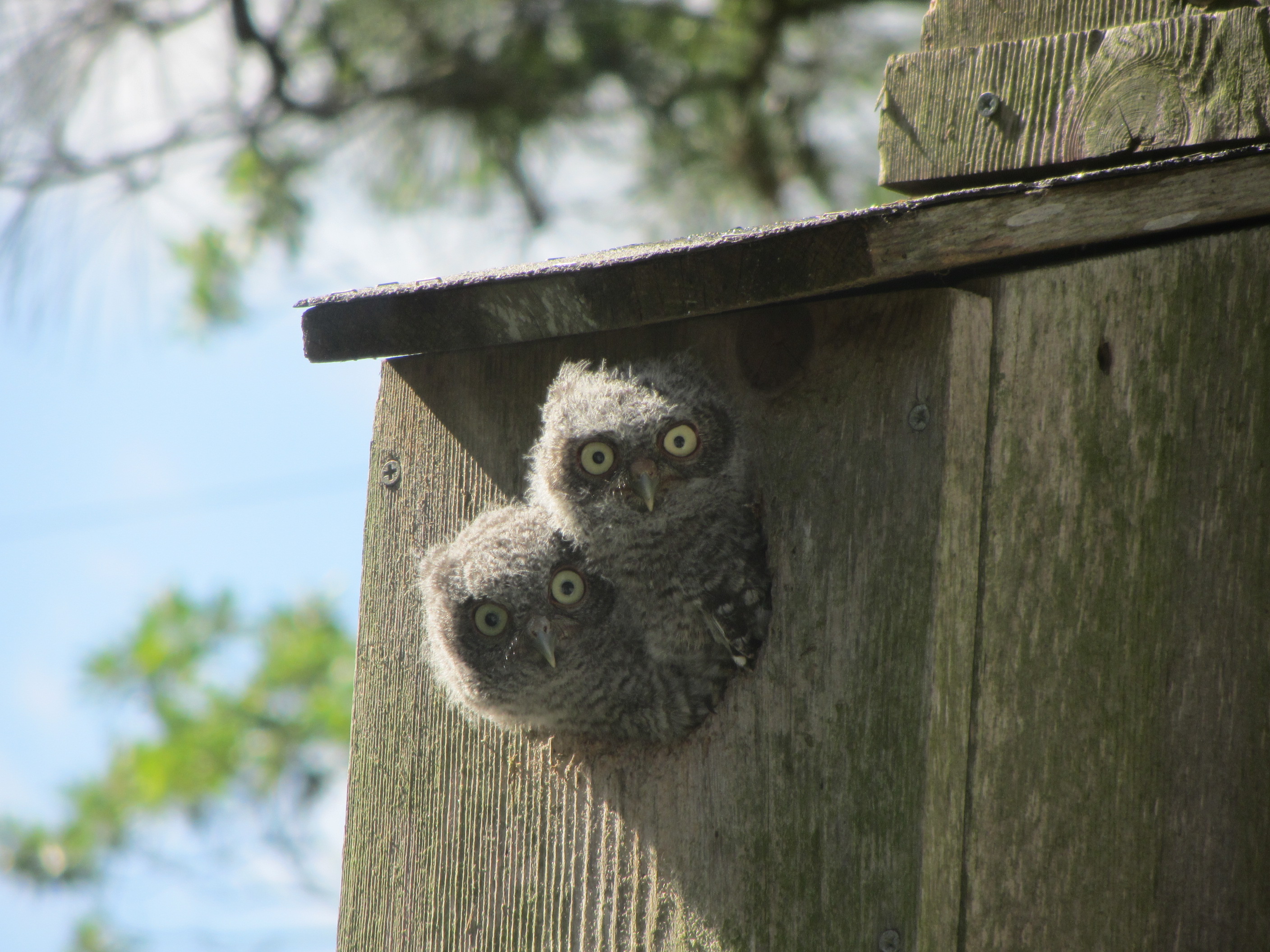
by Carrie Stevenson | Aug 10, 2018
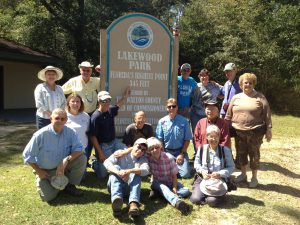
A Florida Master Naturalist Uplands class visits the highest point in Florida, located in Walton County. Photo credit: Carrie Stevenson, UF IFAS Extension
For many Floridians, gardening is a window into learning the cycles of the natural world. Understanding pollination, distinguishing beneficial insects from harmful ones, creating compost, or knowing what time of year to apply iron supplements are important for a gardener to be successful. While we have our share of campers, hikers, and kayakers, over the years Extension agents have found that some of our best Master Naturalist students are those with fond memories of farming or gardening as children or adults.
If you have always been fascinated by the natural world and how plants, animals, and people interact, you might be a perfect candidate for the Master Naturalist program. Offered periodically in almost every county in Florida, this adult educational course combines classroom sessions with field instruction, typically over a six-week period. At graduation, students present an original project, which may vary from creating an exhibit, a children’s book, or even an environmental non-profit organization.
Master Naturalist students vary in backgrounds from retired military and teachers to park rangers and college students. Many Master Gardeners find the courses a helpful addition to their training, and utilize their newly gained knowledge when working with clientele. At completion, students receive an official Florida Master Naturalist certificate, pin, and patch.
The traditional 40-hour courses cover Upland, Coastal, and Freshwater Wetland habitats, while the newer “special topics” cover Conservation Science, Environmental Interpretation, Habitat Evaluation, and Wildlife Monitoring. A new “restoration” series has begun with the Coastal Restoration class, which kicked off in Escambia and Santa Rosa counties and is currently being taught in Bay. Extension agents will be offering several classes in the Panhandle this fall—check out the FMNP registration site to see when a class will be offered near you!
by Daniel J. Leonard | Jul 3, 2018
Each time I travel to central and south Florida and observe the wonderfully flamboyant tropical flora, I am reminded of the unique and frustrating climatic characteristics of Northwest Florida. Our weather is tropical enough through the summer to sustain virtually everything our friends to the south grow, but winters north of the Big Bend are just cold enough to prevent long-term success with most tropical species. However, the genus that is maybe most synonymous with tropical color, the Hibiscus (it even has its own texting emoji!), contains several species that are hardy through our winters. The best landscape plant of these hardy Hibiscus species is creatively (sarcasm) called Hardy Hibiscus or Giant Rose Mallow (Hibiscus moscheutos) and is an absolute star in the Panhandle, bringing the beauty of the tropics to your yard!
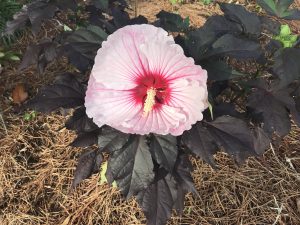
Hibiscus ‘Starry Starry Night’ – Photo courtesy Daniel Leonard
Rose Mallow is a native perennial species that occurs in sunny wetlands across the eastern U.S. This species can grow 7-8’ in height in its natural, unimproved state and possesses the largest flowers of any hardy perennial, some varieties easily eclipse 12” in diameter. Rose Mallows bloom through the heat of our long summers and return reliably each winter unfazed by frost. The flowers also happen to be a favorite of butterflies and hummingbirds and bring beneficial wildlife to the landscape. These characteristics and the trend towards the use of pollinator friendly, low-maintenance native perennials in landscapes quickly made Rose Mallow a jewel for plant breeders and now virtually all major horticultural brands have a line of Hardy Hibiscus available at garden centers, in varying sizes, flower color and leaf color/form. Recent breeding efforts have focused on introducing plants with enormous, richly colored flowers held on compact plants with attractive foliage. The results have yielded two series and three individual cultivars that I consider superior selections and are more than worthy of inclusion in your garden:
- Summerific® Series by Proven Winners. This series is comprised of four robust (up to 5’ in height) cultivars, ‘Cherry Cheesecake’ (bicolor magenta and white flowers), ‘Berry Awesome’ (purplish lavender flowers), ‘Cranberry Crush’ (a red you really have to see to believe), and ‘Perfect Storm’ (notable for its deep purple foliage).
- Luna Series by Monrovia. This series is notable for its ultra-compact (3’ in height or less) size and characteristically large flowers. It is also composed of four cultivars, ‘Luna Red’ (deep red), ‘Luna Blush’ (white, fading to pink near flower margins), ‘Luna Pink Swirl’ (pictured and my favorite, bicolor swirly flowers), and ‘Luna White’ (white with a red center).
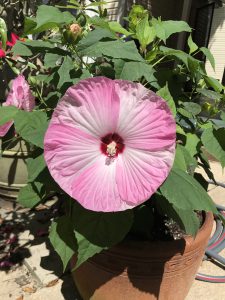
Hibiscus ‘Luna Pink Swirl’ – Photo courtesy Daniel Leonard
- ‘Starry Starry Night’ by Walter’s Gardens. (Pictured) This cultivar combines dark purple to black leaves with swirled pale and dark pink flowers. It has performed very well in my landscape and if I could only grow one, this might be it.
- ‘Lord Baltimore.’ The classic, large growing cultivar with bright red flowers that is widely available and easily found. An oldie (introduced in 1955) but a goodie.
- ‘Midnight Marvel’ by Walter’s Gardens. A “hot off the press” new cultivar that is currently difficult to find due to popularity, though some online outlets have them available in small sizes. This one is worth your patience. Sporting deep red blooms on near black foliage, there’s nothing else like it in the landscape.
In addition to being gorgeous plants, Rose Mallows are extremely versatile in the landscape and could not be easier to grow. Because the size varies so greatly (from the diminutive 30” tall ‘Luna’ series to the 8’ tall unimproved species), there really is a place for one in every garden. I like to use the smaller cultivars in large containers to facilitate moving them around where their floral display has the greatest impact or to create a tropical effect where in ground plantings are not an option (pool decks, patios, etc). The larger cultivars make spectacular specimen plantings in perennial and shrub beds and even make a really dense, striking hedge (just know they disappear in the winter). Be sure to give them as much sun as possible, as this will enhance the number of flowers on each plant and darken the foliage on the cultivars with purplish/black leaves. Too little sun will result in fewer flowers and lighter green foliage. As wetland plants, Rose Mallows enjoy regular water, either from rainfall or irrigation; they will let you know when they need it – their large leaves readily wilt under drought stress, somewhat like Hydrangea.
For low-maintenance, native, pollinator friendly, cold-hardy tropical color, you need look no further than Rose Mallow. These perennial shrubs come in all sizes and colors and fit any landscape! Look for the above listed series and cultivars at better garden centers and online retailers and enjoy the oohs and ahhs elicited when people first get a glimpse of Hardy Hibiscus in your landscape! Happy Gardening!
by Sheila Dunning | Jun 28, 2018
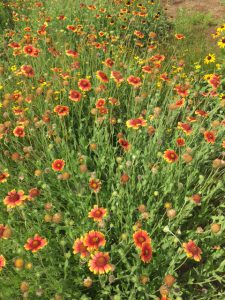 National Pollinator Week is only recognized in June, but efforts to encourage pollinators shouldn’t end then.
National Pollinator Week is only recognized in June, but efforts to encourage pollinators shouldn’t end then.
Pollination occurs when pollen grains are moved between two flowers of the same species, or within a single flower, by wind or animals that are pollinators. Successful pollination, which may require visits by multiple pollinators to a single flower, results in healthy fruit and fertile seeds, allowing plants to reproduce. Without pollinators, we simply wouldn’t have many crops!
Worldwide, approximately 1,000 plants grown for food, beverages, fibers, spices, and medicines need to be pollinated by animals in order to produce the goods on which we depend. Foods and beverages produced with the help of pollinators include blueberries, chocolate, coffee, melons, peaches, pumpkins, vanilla, and almonds.
About 75% of all flowering plants rely on animal pollinators and over 200,000 species of animals act as pollinators. Of those, about 1,000 are hummingbirds, bats, and small mammals. The rest are insects such as beetles, bees, ants, wasps, butterflies, and moths. Western honey bees are the most common.
Most species of bees don’t sting. Although all female bees are physically capable of stinging, most bee species native to the U.S. are “solitary bees,” that is, not living in colonies and don’t sting unless they are physically threatened or injured. Only honey bees are defensive and may chase someone who disturbs their hive.
It is wise, though, to avoid disturbing any bee or insect nest.
What everyone can do for pollinators:
Watch for pollinators. Get connected with nature. Take a walk, experience the landscape and look for pollinators which are most active midday in sunny, planted areas.
Reduce your impact. Reduce or eliminate your pesticide use, increase green spaces, and minimize impervious surfaces.
Plant for pollinators. Create pollinator-friendly habitat with native flowering plants that supply pollinators with nectar, pollen, and homes. For a list of plant choices go to: http://gardeningsolutions.ifas.ufl.edu/design/gardening-with-wildlife/bee-plants.html
What you can do to create a pollinator-friendly habitat:
Design your garden so that there is a continuous succession of plants flowering from spring through fall. Check for the species or cultivars best suited to your area.
Plant native to your region using plants that provide nectar for adults plus food for insect larvae, such as milkweed for monarchs. If you do use non-native plants, choose ones that don’t spread easily, since these could become invasive.
Select old-fashioned varieties of flowers whenever possible because breeding has caused some modern blooms to lose their fragrance and/or the nectar/pollen needed to attract and feed pollinators.
Install ‘houses’ for bats and native bees. For examples go to: http://edis.ifas.ufl.edu/uw290 or http://gardeningsolutions.ifas.ufl.edu/design/gardening-with-wildlife/pollinator-hotels.html
Avoid pesticides, even so-called “natural” ones such as Bacillus thuringiensis (Bt). If you must use them, use the most selective and least toxic ones and apply them at night when most pollinators aren’t active.
Supply water for all wildlife. A dripping faucet or a suspended container with a pinhole in the bottom is sufficient for some insects. Other wildlife need a small dish of water.
Provide water for butterflies without letting it become a mosquito breeding area. Refill containers daily or bury a shallow plant saucer to its rim in a sunny area, fill it with coarse pine bark, sand or stones and fill to overflowing with water.
Fun facts:
A tiny fly (a “midge”) no bigger than a pinhead is responsible for the world’s supply of chocolate
One out of every three mouthfuls of food we eat is delivered to us by pollinators.
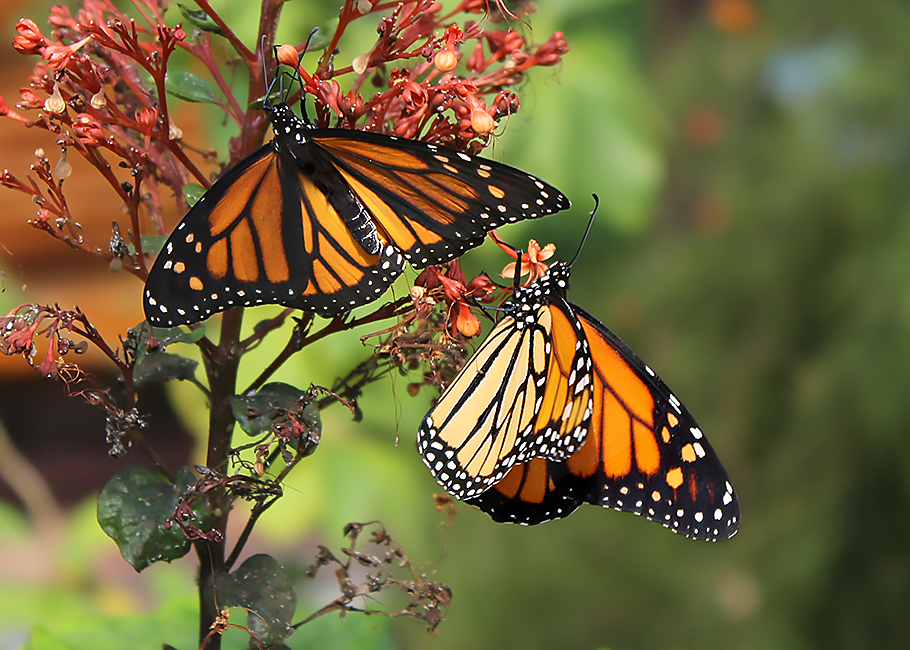
by Mary Salinas | Dec 14, 2017
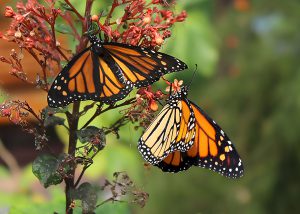
Monarch butterflies. Photo credit: Pia-Riitta Klein.
We have grown to love monarch butterflies, with their striking orange and black markings and their fascinating annual migration from southern Canada 3,000 miles south to Mexico. To help them, we have increasingly planted milkweed, the only plant on which their caterpillars will feed. In northwest Florida, the milkweed species most planted has been tropical milkweed, Asclepias curassavica, as it is lush, showy and easy to grow.
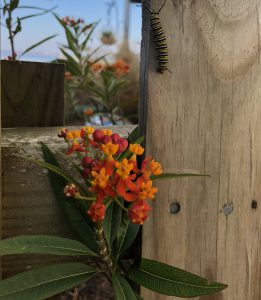
Tropical milkweed, Asclepias curassavica, was visited by this monarch caterpillar who is now off to find a suitable place to make his transformation into a chrysalis. Photo by Mary Salinas, UF/IFAS Extension.
Tropical milkweed, unlike our native milkweeds that die back in late fall, will continue to grow through the winter unless killed by a hard freeze. Even if the cold kills the stems, it may regrow quickly from the roots. This seems like an advantage, but maybe not. The availability of a host plant for the caterpillars may be prompting adult females to stay and lay eggs rather than migrate south and be protected from deadly freezes.
Experts are also exploring links between the longer persistence of the tropical milkweed into winter and a build-up on those plants of a serious parasite Ophryocystis elektroscirrha, commonly referred to as OE.
So, what is the answer?
- Cut back any tropical milkweed to the ground at Thanksgiving. That may encourage female monarchs to migrate and prevent a deadly build-up of OE spores on the plants.
- Consider adding some native milkweed species to your butterfly garden. Here are some recommended species from Dr. Jaret Daniels:
- Aquatic Milkweed (Asclepias perennis)
- Swamp Milkweed (Asclepias incarnata)
- Pinewoods Milkweed (Asclepias humistrata)
- Redring Milkweed (Asclepias variegata)
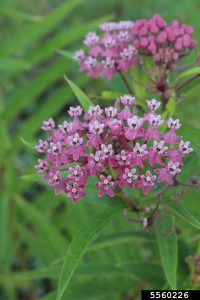
Swamp Milkweed, Asclepias incarnata. Photo credit: Chris Evans, University of Illinois.
For more information:
Are non-native milkweeds killing monarch butterflies?
Monarch Joint Venture: Potential risks of growing exotic (non-native) milkweeds for monarchs
Monarch Butterfly, Danaus plexippus Linnaeus (Lepidoptera: Nymphalidae: Danainae)
MonarchWatch.org
Gardening Solutions: Milkweed















